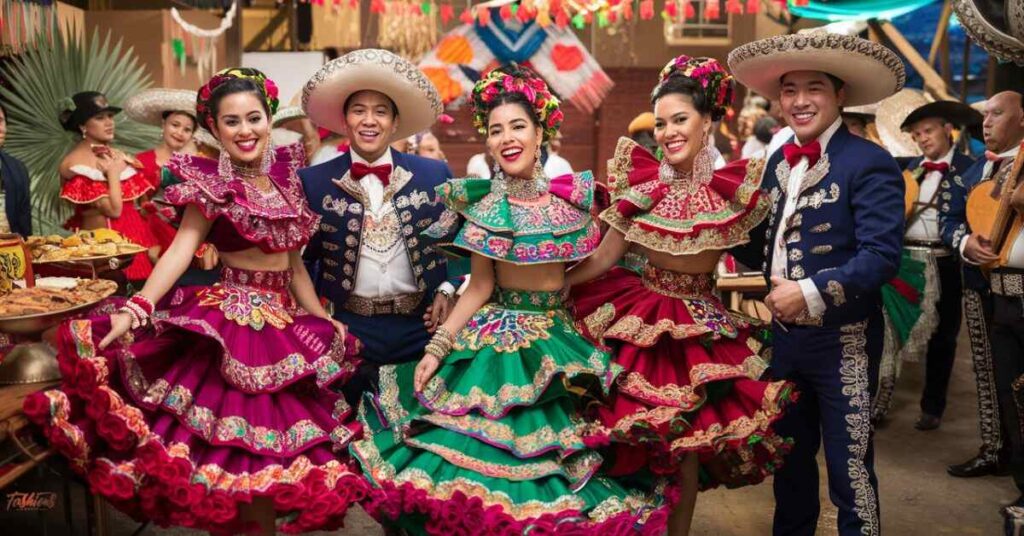Mexico’s traditional clothing is a vibrant tapestry of colors, patterns, and cultural influences that have been woven into the fabric of the nation’s identity. From the iconic huipil to the elaborate Tehuana dresses, each garment tells a story of resilience, creativity and cultural pride.
These garments are not merely pieces of fabric, but rather living expressions of Mexico’s rich indigenous heritage and the artistry of its people.
Top 10 Traditional Mexican Clothes
Here is a top ten Maxican traditional clothes:
The Huicholes of Nayarit
The Huicholes, an indigenous community from the western state of Nayarit, are renowned for their intricate and vibrant traditional dress. The women’s attire features a long, embroidered skirt paired with a huipil, a sleeveless tunic adorned with intricate designs that hold deep symbolic meaning.
The men’s clothing, on the other hand, often consists of a white cotton shirt and trousers. This is complemented by a colorful sarape (a woven blanket or shawl) and a sombrero (wide-brimmed hat)..
Typical Costume of Veracruz
The state of Veracruz, located on Mexico’s Gulf Coast, is home to a diverse range of traditional clothing styles influenced by its rich cultural tapestry. One of the most iconic garments is the huipil, which features intricate embroidery and vibrant colors that vary depending on the region.
The women’s ensemble is often completed with a flowing skirt and a rebozo (a shawl or scarf) draped elegantly over the shoulders.
Mexican Clothes from Jalisco: The Charro Outfit
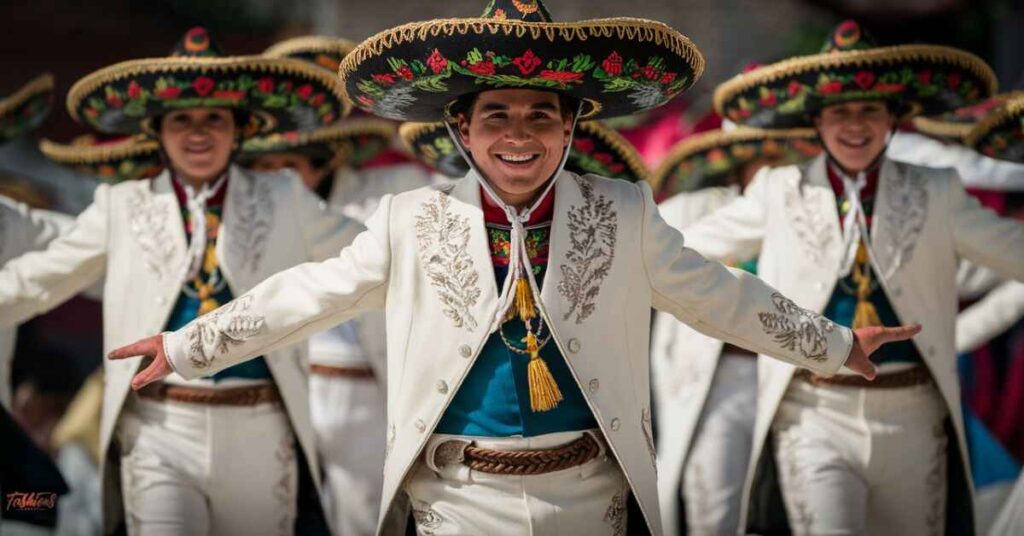
The Charro outfit, a quintessential symbol of Mexican culture, originated in the state of Jalisco. This iconic ensemble is characterized by an elaborately embroidered suit, often featuring intricate designs inspired by the region’s history and traditions.
The Charro outfit is commonly worn by horsemen and mariachi musicians, and it has become a symbol of Mexican masculinity and pride.
Typical Costume of Nuevo Leon
The traditional dress of Nuevo Leon, a northern state in Mexico, is influenced by its arid climate and ranching culture. The women’s attire typically includes a long, flowing skirt paired with a blouse adorned with delicate embroidery, often featuring floral motifs.
The men’s clothing, on the other hand, is characterized by rugged elements, such as leather chaps, boots, and a sombrero, reflecting the region’s deep connection to the land and cattle ranching traditions.
La China Poblana Outfit from Puebla
The China Poblana outfit, originating from the city of Puebla, is a testament to the fusion of Spanish and indigenous influences in Mexican traditional dress. This iconic ensemble features a voluminous skirt made of vibrant fabrics, often adorned with intricate embroidery and lace detailing.
The outfit is completed with a delicately embroidered blouse and a rebozo draped gracefully over the shoulders.
Traditional Mexican Clothing of Chiapas
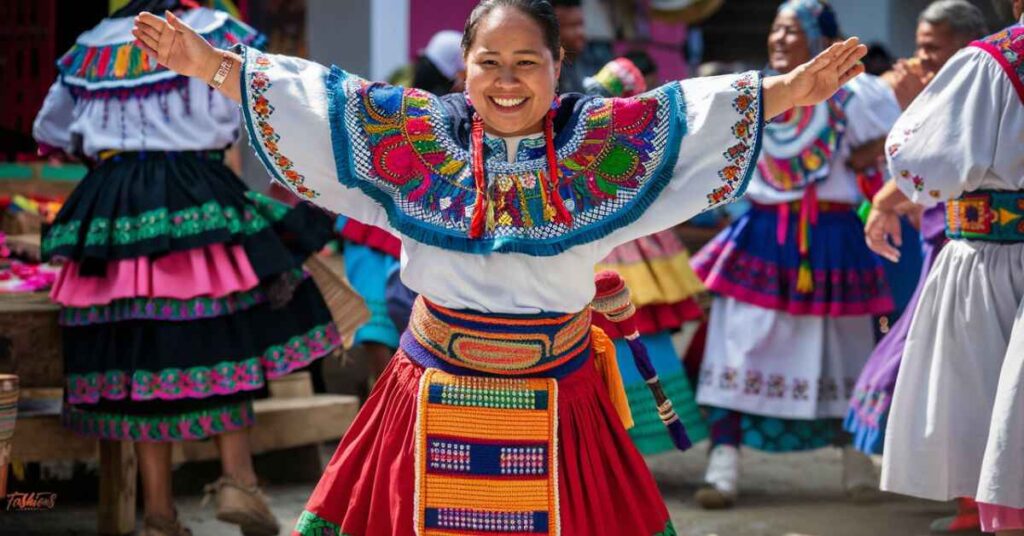
The state of Chiapas, located in southern Mexico, is home to a rich tapestry of indigenous cultures, each with its own distinct traditional dress. The Tzotzil and Tzeltal communities are renowned for their intricate weaving techniques and the vibrant colors that adorn their garments.
Women often wear huipiles adorned with intricate embroidery, paired with elaborate skirts and colorful rebozos.
Typical Costume of Yucatan
The traditional clothing of the Yucatán Peninsula is heavily influenced by the region’s Mayan heritage. Women’s attires often feature the huipil, a sleeveless tunic made of intricately woven fabric adorned with geometric patterns and vibrant colors.
These garments are paired with long, flowing skirts and complemented by a rebozo or a finely woven shawl.
Traditional Mexican Clothing of San Luis Potosí
The state of San Luis Potosí is known for its intricate lace-making traditions, which are reflected in its traditional clothing. Women’s dresses often feature delicate lace detailing, intricate embroidery, and vibrant colors.
The men’s attire, on the other hand, is characterized by simple yet elegant elements, such as white cotton shirts and trousers, complemented by a sombrero and a sarape.
Typical Costume of Oaxaca
Oaxaca, a state known for its rich indigenous traditions, is home to the iconic Tehuana dress. This elaborate ensemble features a richly embroidered huipil tunic, often adorned with intricate floral designs and symbolic motifs.
It is paired with a voluminous skirt that cascades in layers of vibrant colors and textures. The Tehuana dress is a true masterpiece of Mexican textile art and holds deep cultural significance for the Zapotec women who wear it.
Typical Attire of Quintana Roo
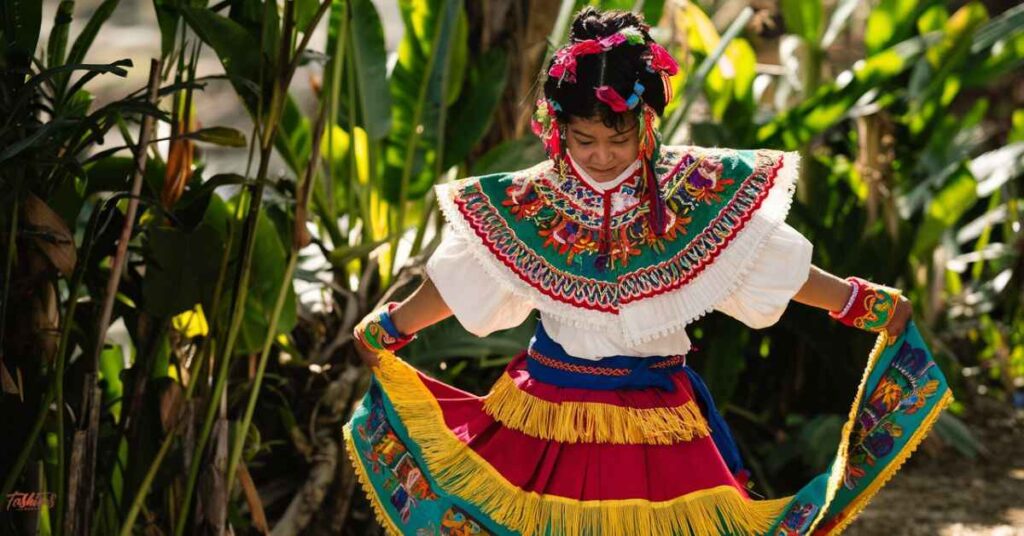
The traditional clothing of Quintana Roo, a state located in the Yucatán Peninsula, is heavily influenced by the region’s Mayan heritage. Women often wear the huipil, a sleeveless tunic adorned with intricate embroidery and geometric patterns, paired with a long, flowing skirt or a traditional wrap-around garment known as a fustán.
The men’s attire typically consists of loose-fitting cotton shirts and trousers, complemented by a sombrero and a woven shawl or sarape.
Frida Kahlo Put Traditional Mexican Clothing Under the Spotlight
No discussion of traditional Mexican dress would be complete without mentioning the iconic artist Frida Kahlo. Known for her bold self-portraits and her unapologetic embrace of her Mexican heritage, Kahlo played a significant role in bringing traditional Mexican clothing to the forefront of popular culture.
Kahlo’s signature style, which often featured intricately embroidered huipiles, vibrant rebozos, and elaborate floral headpieces, was a celebration of her indigenous roots and a defiant statement against the cultural homogenization of the time. Her ensembles were not merely fashion statements but powerful symbols of resistance and cultural pride.
Through her art and her personal style, Kahlo challenged societal norms and inspired generations of Mexican women to embrace their cultural heritage and traditions. Her impact on the world of fashion and art is undeniable. Her legacy continues to inspire designers and artists alike to celebrate the richness and diversity of Mexican traditional dress.
Characteristics of a Traditional Mexican Outfit
Traditional Mexican outfits are characterized by a harmonious blend of vibrant colors, intricate embroidery, and symbolic motifs. These elements reflect the rich cultural tapestry of the country. Here are some of the key characteristics that define a traditional Mexican outfit:

Vibrant Colors
Mexican traditional dress is renowned for its bold and vibrant color palettes, often featuring hues like red, purple, yellow, and turquoise. These colors are believed to have symbolic meanings and are deeply rooted in the country’s indigenous traditions.
Intricate Embroidery
Embroidery is an integral part of Mexican traditional dress, with each region boasting its own unique styles and techniques. From the delicate floral patterns of the Poblana dress to the intricate geometric designs of the Huichol community, embroidery is a form of storytelling and artistic expression.
Symbolic Motifs
Many traditional Mexican garments are adorned with symbolic motifs that hold deep cultural and spiritual significance. These motifs can depict elements of nature, religious beliefs, or historical events, serving as a visual representation of the wearer’s cultural identity.
Natural Fibers
Traditional Mexican clothing is often made from natural fibers such as cotton, wool and silk, which are sourced locally and woven using age-old techniques. These fabrics not only contribute to the garments’ breathability and comfort but also reflect the sustainable practices of indigenous communities.
Regional Variations
Each region in Mexico has its own distinct traditional dress, reflecting the diversity of the country’s indigenous cultures. From the Tehuana dresses of Oaxaca to the Charro outfits of Jalisco, these regional variations showcase the richness and depth of Mexico’s cultural heritage.
Accessories
Traditional Mexican outfits are often complemented by a range of accessories, such as rebozos (shawls), sarapes (woven blankets or cloaks), sombreros (wide-brimmed hats) and huaraches (traditional sandals). These accessories add flair and cultural significance to the overall ensemble. These accessories not only add to the overall aesthetic but also serve practical purposes and hold cultural significance.
Read this blog:
What Is A Wrap Dress?
Tehuana Traditional Dress Firsthand While Traveling Through Oaxaca
One of the most iconic and breathtaking examples of traditional Mexican dress is the Tehuana ensemble, originating from the Isthmus of Tehuantepec region in Oaxaca. For those seeking to witness the beauty and cultural significance of this garment firsthand, a visit to Oaxaca is an absolute must.

As you explore the vibrant streets of Oaxaca City, you’ll be captivated by the sight of Tehuana women adorned in their resplendent attire. This is a testament to the enduring traditions of the Zapotec people. The Tehuana dress is a true masterpiece of textile art. It features a richly embroidered huipil tunic adorned with intricate floral designs and symbolic motifs that tell stories of the region’s history and cultural heritage.
Paired with the huipil is a voluminous skirt that cascades in layers of vibrant colors and textures, often featuring elaborate embroidery and delicate lace detailing. These skirts are works of art in themselves, with each layer representing the intricate craftsmanship and dedication of the skilled artisans who create them.
One of the best ways to truly experience the Tehuana dress is to attend a cultural festival or celebration in Oaxaca. During events like the annual Guelaguetza festival, the streets come alive with a vibrant procession of Tehuana women donning their finest attire. They are accompanied by the rhythmic beat of traditional music and dance.
For those seeking a more immersive experience, consider participating in a workshop or visiting a local artisan’s studio. Here, you’ll have the opportunity to witness the painstaking process of creating a Tehuana dress. This includes observing the intricate embroidery techniques and the meticulous weaving of the fabric itself
Marvel at Mexican Folklore Clothing Up Close in the Yucatán Peninsula

The Yucatán Peninsula, home to the ancient Mayan civilization, is a treasure trove of cultural richness and tradition. Here, the vibrant hues and intricate patterns of Mexican folklore clothing come to life. They offer visitors a unique opportunity to marvel at the artistry and symbolism that adorn these garments.
As you explore the charming towns and villages of the Yucatán, you’ll be greeted by the sight of local women adorned in their traditional huipiles. These sleeveless tunic dresses are adorned with intricate embroidery and geometric patterns that echo the region’s Mayan heritage. These garments are not merely pieces of clothing but living canvases that celebrate the rich tapestry of Yucatecan culture.
One of the best ways to immerse yourself in this cultural experience is to attend a local festival or celebration. During events like the Mérida Fest or the Día de Muertos (Day of the Dead) festivities, the streets come alive with a vibrant display of traditional dress, music, and dance. This provides a truly immersive and authentic experience for everyone involved.
Whether you’re marveling at the intricate details of a huipil or admiring the graceful movements of a traditional dance, the Yucatán Peninsula offers a truly immersive and captivating experience. It’s perfect for those seeking to appreciate the rich cultural heritage of Mexican folklore clothing.
The Clothing of the Tehuana
The Tehuana dress, originating from the Isthmus of Tehuantepec region in Oaxaca, is a true masterpiece of Mexican textile art. It’s also a powerful symbol of cultural identity for the Zapotec women who wear it. This elaborate ensemble is a testament to the enduring traditions and creativity of the indigenous communities that have preserved and celebrated this iconic garment for generations.

At the heart of the Tehuana dress is the huipil, a sleeveless tunic adorned with intricate embroidery and symbolic motifs. These elements tell stories of the region’s history and cultural heritage. These huipiles are works of art in themselves, with each stitch and pattern holding deep meaning and significance.
Paired with the huipil is a voluminous skirt that cascades in layers of vibrant colors and textures. These skirts are often adorned with elaborate embroidery, delicate lace detailing, and intricate patterns. These elements showcase the incredible skill and dedication of the artisans who create them.
One of the most striking features of the Tehuana dress is the intricate headdress, known as the resplandor, which is adorned with ruffles, ribbons, and intricate embroidery. This headdress not only adds to the overall grandeur of the ensemble but also holds deep symbolic significance. It represents the strength and resilience of the Zapotec women who wear it.
Beyond its aesthetic beauty, the Tehuana dress is a powerful expression of cultural identity and resistance. During the colonial era, when many indigenous traditions were suppressed, the Tehuana women continued to wear their traditional dress. This act served as a defiant means of preserving their cultural heritage.
The Huipil: A Sleeveless Tunic Made from Traditional Mexican Cloth
The huipil is a sleeveless tunic that is an essential component of traditional Mexican dress, particularly among the indigenous communities of the country. This garment, which has its roots in pre-Hispanic times, has evolved over the centuries, reflecting the diverse cultural influences and artistic expressions of various regions.
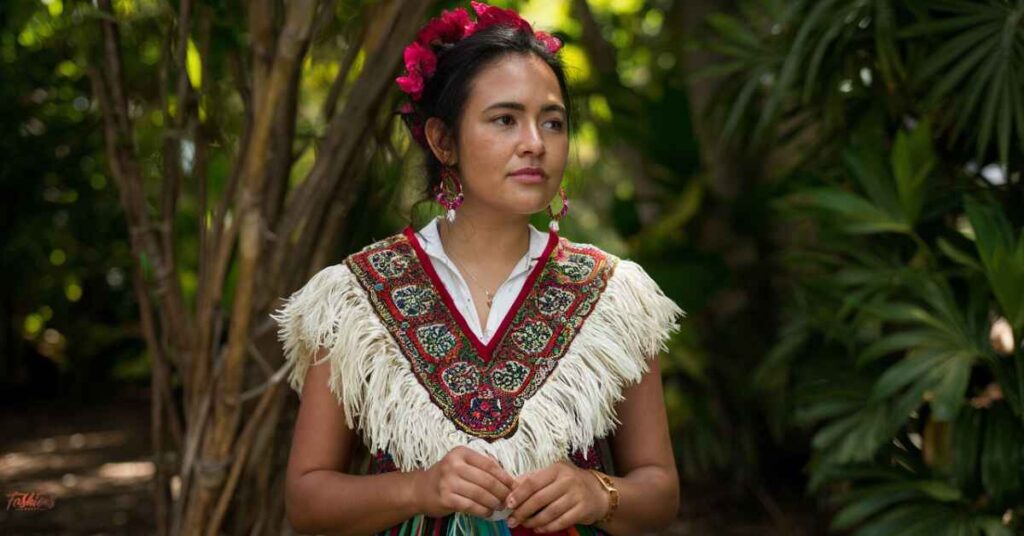
At its core, the huipil is a simple yet versatile garment, typically made from intricately woven cloth, often featuring intricate patterns and vibrant colors. The beauty of the huipil lies in the intricate details that adorn it, with each region boasting its own unique styles and techniques.
In Oaxaca, the huipiles are true masterpieces of textile art, with each stitch and pattern holding deep symbolic meaning. The skilled artisans of the region have mastered the art of brocading. This technique involves embroidering intricate designs directly onto the fabric as it is being woven.
Beyond its aesthetic appeal, the huipil holds deep cultural significance for the indigenous communities of Mexico. It is a powerful symbol of identity, resilience and the preservation of ancient traditions. For many women, the act of weaving and embroidering a huipil is not merely a craft but a sacred ritual passed down through generations. It connects them to their ancestors and their cultural roots.
The Blouse: A Staple in Mexican National Costume
The blouse or camisa, is an essential component of traditional Mexican dress, serving as a staple in both women’s and men’s national costumes. While the styles and embellishments may vary across regions, the blouse holds a significant place in the country’s sartorial heritage. It reflects the cultural exchange and influences that have shaped Mexico’s identity over centuries.
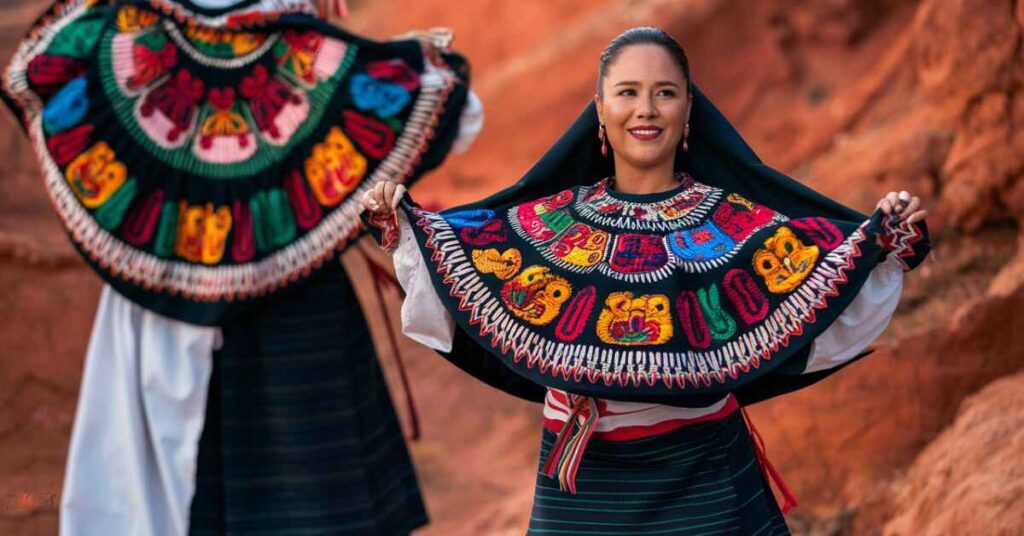
For women, the blouse is often a delicate and intricately embroidered garment. It’s designed to complement the vibrant skirts and huipiles that make up the traditional ensemble. In regions like Puebla, the blouses are renowned for their exquisite floral embroidery, featuring intricate patterns adorned with delicate beadwork and lace detailing. These embroidered blouses are not only visually stunning but also serve as a canvas for storytelling, with each motif and design holding symbolic meaning and cultural significance.
In contrast, the men’s blouses, often referred to as camisas, are typically simpler in design, yet no less significant in their cultural representation. These loose-fitting, white cotton shirts are a staple in ensembles such as the iconic Charro outfit, popular in the state of Jalisco. The simplicity of these blouses allows for the intricate embroidery and ornate details of the accompanying trousers and jackets to take center stage.
Beyond their aesthetic appeal, the blouses in Mexican traditional dress hold a deeper cultural significance. They represent the fusion of indigenous and colonial influences, reflecting the rich tapestry of Mexico’s history. The intricate embroidery techniques, for instance, are a testament to the enduring artistry of indigenous communities, while the lace and delicate detailing bear the mark of Spanish colonial influences.
The Sarape: Traditional Mexican Men’s Clothing
The sarape, a woven blanket or cloak, is an iconic piece of traditional Mexican men’s clothing that has been woven into the fabric of the country’s cultural identity. This versatile garment, originally worn by indigenous communities for warmth and protection, has evolved over the centuries to become a symbol of Mexican pride and craftsmanship.
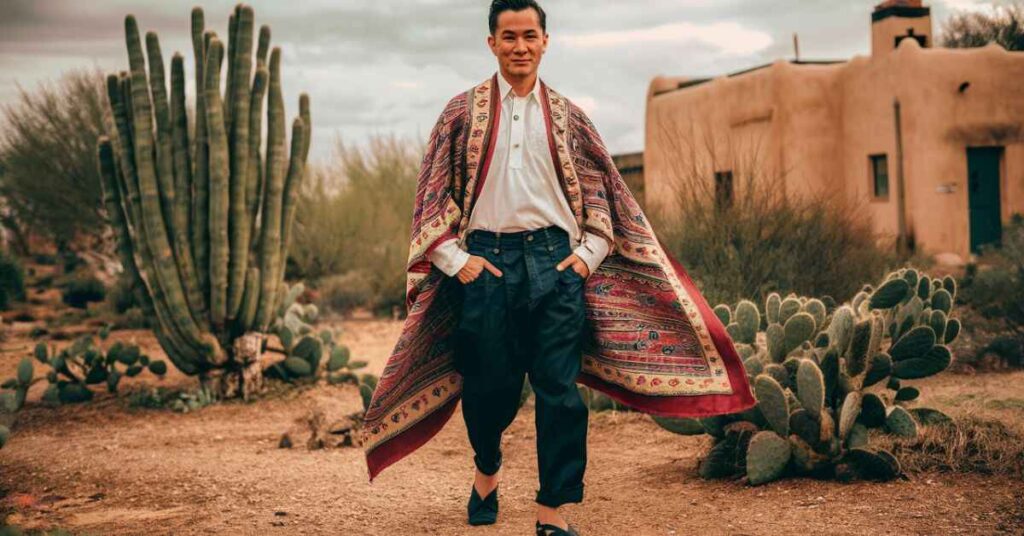
At its core, the sarape is a testament to the skilled artistry of Mexican weavers, who have mastered the intricate techniques of creating these intricately patterned textiles. Traditionally woven from wool, the sarape features vibrant colors and intricate designs. It often incorporates geometric patterns, floral motifs, and symbolic elements that reflect the rich cultural heritage of the region from which it originates.
In the state of Oaxaca, for example, the sarapes are renowned for their tapestry-like quality, with intricate designs that tell stories of the region’s history and mythology. The skilled weavers of this region have perfected the art of ikat dyeing. This technique creates stunning patterns by selectively binding and dyeing the threads before weaving.
On the other hand, in the Yucatán Peninsula, the sarapes are characterized by their bold geometric patterns and vibrant hues. These elements echo the region’s Mayan heritage and the use of natural dyes derived from local plants and minerals.
Beyond its aesthetic appeal, the sarape holds profound cultural significance for Mexican men. It is not merely a garment but a symbol of identity, resilience and the enduring traditions of indigenous communities. In many regions, the sarape is an integral part of traditional dress, worn with pride during celebrations, festivals and cultural events.
The Rebozo: A Key Element of Traditional Female Mexican Attire
The rebozo, a traditional shawl or scarf, is an essential element of Mexican women’s attire, serving not only as a functional accessory but also as a powerful symbol of cultural identity and feminine grace. This versatile garment, often intricately woven and adorned with intricate patterns and vibrant colors, has been an integral part of Mexican traditional dress for centuries.
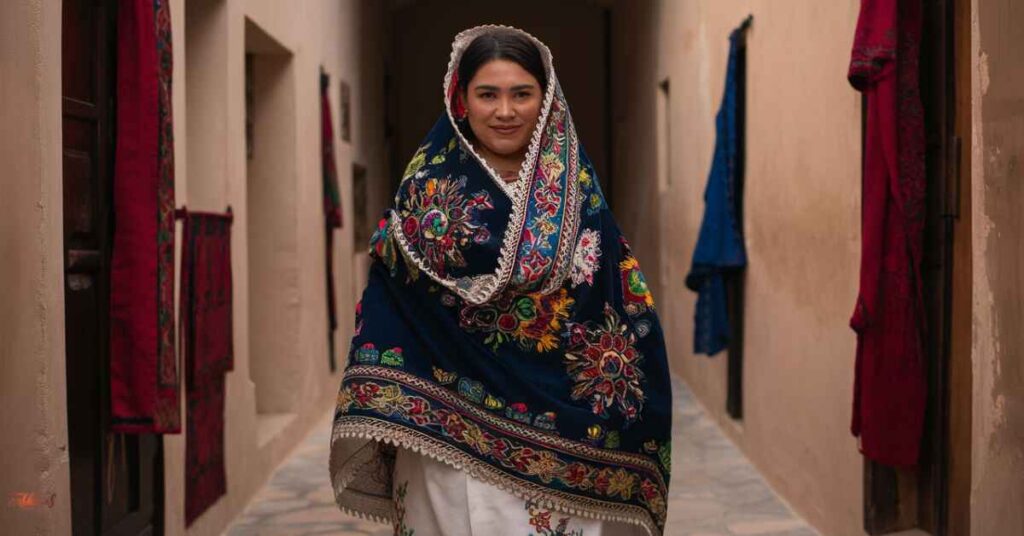
At its core, the rebozo is a testament to the skilled artistry of Mexican weavers, who have mastered the intricate techniques of creating these exquisite textiles. Traditionally woven from natural fibers such as cotton, silk, or wool, the rebozo features vibrant colors and intricate designs, often incorporating floral motifs, geometric patterns, and symbolic elements that reflect the rich cultural heritage of the region from which it originates.
In the state of Oaxaca, for example, the rebozos are renowned for their intricate brocade work, with skilled artisans meticulously embroidering intricate designs directly onto the fabric as it is being woven. These rebozos are not only visually stunning but also serve as canvases for storytelling, with each motif and design holding symbolic meaning and cultural significance.
Beyond its aesthetic appeal, the rebozo holds profound cultural significance for Mexican women. It is a versatile garment that can be worn in a multitude of ways. It serves as a shawl, a headscarf, or even a makeshift carrier for carrying infants or small items. This versatility has made the rebozo an indispensable accessory for generations of Mexican women, accompanying them through the various stages and rituals of life.
Also read:
How To Wear A Belt With A Dress Plus Size?
The Skirt: An Essential Item of Popular Mexican Clothing
The skirt or falda, is an essential component of traditional Mexican dress, particularly for women. This versatile garment has been woven into the cultural fabric of Mexico, reflecting the diverse regional influences and artistic expressions that have shaped the country’s sartorial heritage.
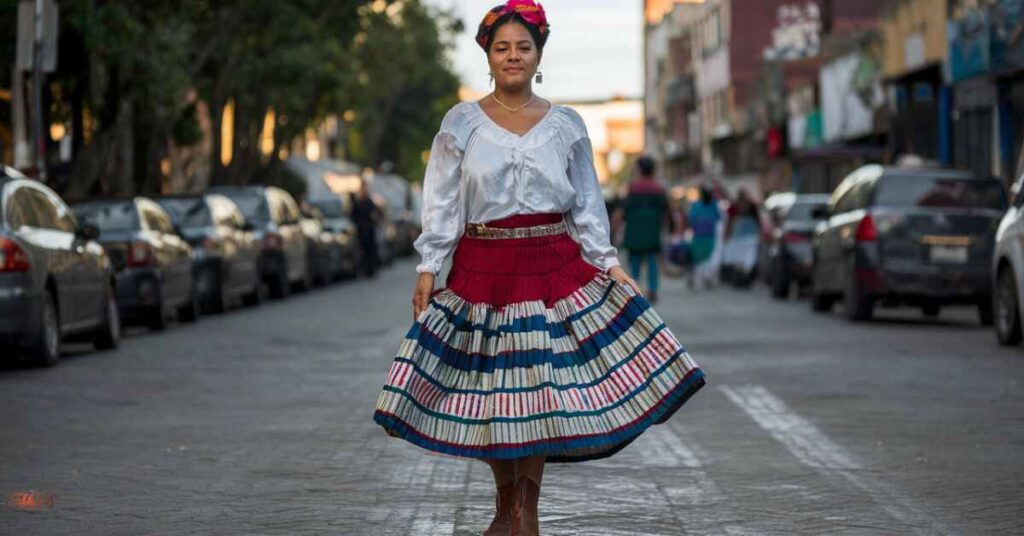
At its core, the Mexican skirt is a celebration of color, texture and intricate craftsmanship. From the vibrant hues of the Tehuana skirts of Oaxaca to the delicate lace and embroidery of the Poblana skirts from Puebla, each region boasts its unique styles and techniques. These reflect the rich tapestry of Mexico’s indigenous and colonial influences.
In the state of Chiapas, for example, the skirts worn by the Tzotzil and Tzeltal women are true works of art. These voluminous garments, often featuring intricate brocade work and vibrant patterns, are not only visually stunning. They also hold deep cultural significance, serving as a canvas for storytelling and the preservation of ancient traditions.
Similarly, in the Yucatán Peninsula, the skirts are characterized by their bold geometric patterns and the use of natural dyes derived from local plants and minerals, echoing the region’s Mayan heritage and the enduring artistry of its indigenous communities.
Beyond their aesthetic appeal, the Mexican skirt holds profound cultural and practical significance. In many regions, the skirt is a versatile garment, often worn as part of traditional dress but also adapted for daily wear. The voluminous silhouettes and layered designs not only reflect the artistic traditions of the region but also serve as a practical solution for navigating the diverse climates and terrains of Mexico.
Frequently asked questions
What is the clothing like in Mexico?
Clothing in Mexico reflects a rich blend of vibrant colors, intricate patterns, and cultural symbolism. It varies across regions, showcasing a mix of indigenous heritage and colonial influences.
What is the history of the tehuana dress?
The Tehuana dress has a rich history originating from the Isthmus of Tehuantepec region in Oaxaca, serving as a powerful symbol of cultural identity for Zapotec women. It has been worn defiantly to preserve traditions during periods of cultural suppression.
What is the name of the Cinco de Mayo dress?
The traditional dress worn on Cinco de Mayo is called “La China Poblana” or simply “Poblana dress.”
Is Cinco de Mayo only for Mexican?
Cinco de Mayo is primarily a Mexican celebration, but it’s also embraced by many people of various backgrounds who appreciate Mexican culture and history.
Conclusion
Traditional Mexican dress is a vibrant tapestry that celebrates the country’s rich cultural heritage and the enduring artistry of its people. From the iconic huipil to the elaborate Tehuana ensemble, each garment is a masterpiece of textile art, telling stories of resilience, creativity, and cultural pride.
As we explore the diverse regional treasures that adorn the bodies and souls of Mexico’s people, we are reminded of the enduring spirit of a nation that has preserved its traditions in the face of adversity. Embracing traditional Mexican dress is a powerful way to honor the past, celebrate the present, and inspire future generations to appreciate the beauty and resilience woven into the fabric of Mexican culture.

